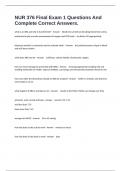NUR 376 Final Exam 1 Questions And
Complete Correct Answers.
what is an ABG and why is it performed? - Answer blood test carried out by taking blood from artery.
performed to get accurate measurement of oxygen and CO2 levels -- to deliver O2 appropriately
blood gas analysis is commonly used to evaluate what? - Answer the partial pressures of gas in blood
and acid base content
what does ABG test for - Answer acid/base, carbon dioxide, bicarbonate, oxygen
how can nerve damage be prevented with ABGs - Answer choosing appropriate sampling site and
avoiding redirection of needle. expel air bubbles, cap syringe and roll specimen between hands to mix
how soon after the blood draw should an ABG be analyzed - Answer within 15 minutes and stored at
room temp or on ice
what happens if ABG is not kept on ice - Answer results of pH, PaO2, PaCO2 can change over time
pH levels. acid, normal and base - Answer normal 7.35-7.45
acid less than 7.35
base more than 7.45
average for PaCO2 - Answer 35 to 45 mmHg
how fast does it take acid to work - Answer minutes to hours
how fast does it take base to work - Answer days
,lungs love ____
kidneys love ____ - Answer acid
base
average for HCO3- - Answer 22 to 26 mEq/L
average for PaO2 - Answer 80-100 mmHg
average O2 saturation - Answer 94%
characteristics of metabolic acidosis. - Answer low pH, low bicarbonate
most commonly due to kidney injury or acute kidney failure
correct with dialysis
causes of metabolic acidosis - Answer DKA, hyperkalemia, starvation, shock, acute/chronic renal
failure, aspirin overdose, tricyclic antidepressant overdose, DIARRHEA
S/S of metabolic acidosis - Answer headache, confusion, drowsiness, increased RR and depth, decrease
BP, decreased CO, dysrhythmias, shock
characteristics of metabolic alkalosis - Answer high pH, high bicarbonate
most commonly due to vomiting or gastric suction
may be due to medications (long term diuretic)
S/S metabolic alkalosis - Answer symptoms related to decreased calcium, respiratory depression,
tachycardia, symptoms of hypokalemia
what will produce alkalosis - Answer hypokalemia
causes of metabolic alkalosis - Answer decreased acid, increased base
, large blood transfusion, prolonged vomiting, eating disorders/bulimia, significant NG drainage/output,
diuretic overuse, hypokalemia, mineralocorticoid excess
characteristics of respiratory acidosis - Answer low pH, high bicarbonate
treatment aimed at improving ventilation
ALWAYS DUE TO RESPIRATORY PROBLEM WITH INADEQUATE EXCRETION OF CO2 (COPD)
chronic respiratory acidosis --- body may compensate, may be asymptomatic
causes of respiratory acidosis - Answer respiratory distress/failure, COPD (retaining CO2), emphysema,
airway obstruction, laryngospasm, neuromuscular disorders (Guillain Barre), sedative overdose
high CO2, rapid respirations due to retaining CO2
S/S of respiratory acidosis - Answer sudden increased pulse, RR, and BP
mental changes, feeling of fullness in head
What is Guillain-Barre syndrome? - Answer paralysis starting in lower extremity (affects diaphragm)
characteristics of respiratory alkalosis - Answer high pH, low bicarbonate
ALWAYS DUE TO HYPERVENTILATION (not blowing off the CO2)
causes of respiratory alkalosis - Answer hyperventilation (most common)
pulmonary embolism
pneumothorax (collapsed lung)
fever
high altitude
anxiety




